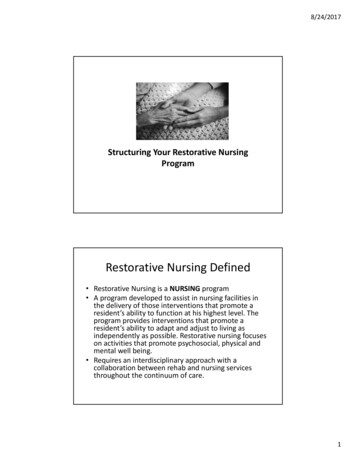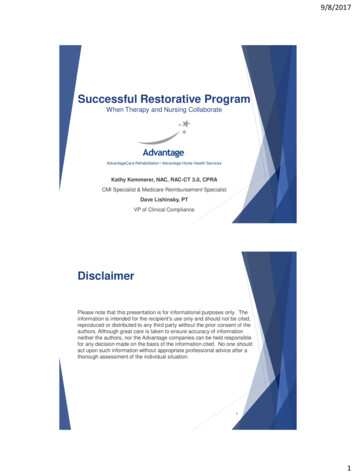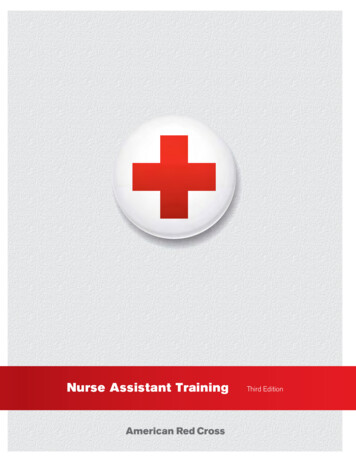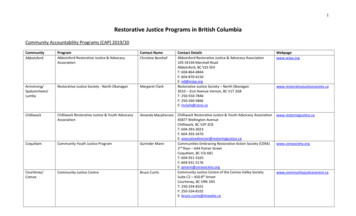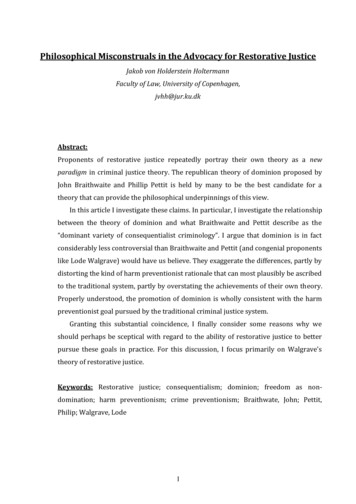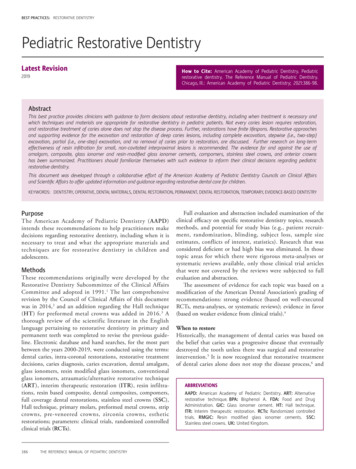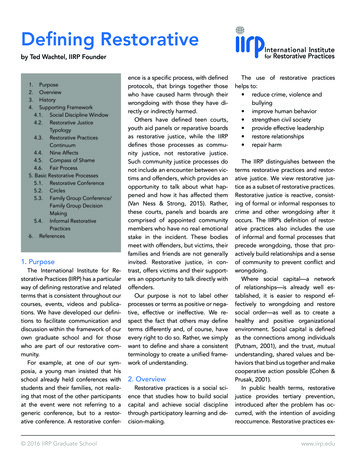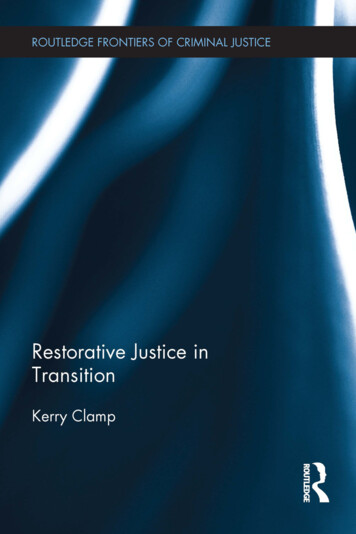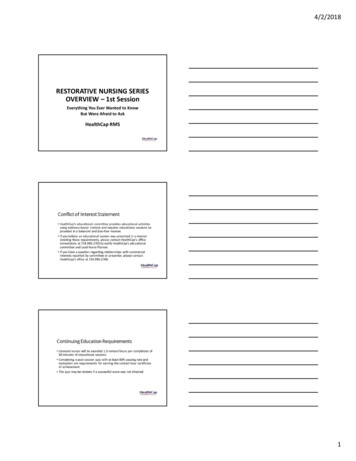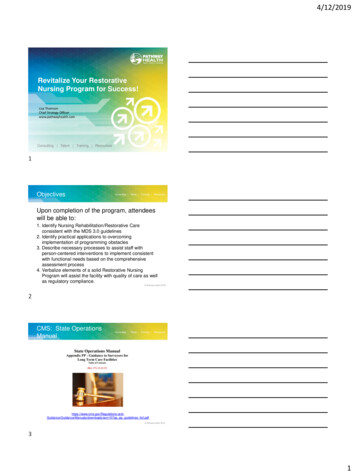
Transcription
4/12/2019Revitalize Your RestorativeNursing Program for Success!Lisa ThomsonChief Strategy Officerwww.pathwayhealth.comConsulting Talent Training Resources1ObjectivesConsulting Talent Training ResourcesUpon completion of the program, attendeeswill be able to:1. Identify Nursing Rehabilitation/Restorative Careconsistent with the MDS 3.0 guidelines2. Identify practical applications to overcomingimplementation of programming obstacles3. Describe necessary processes to assist staff withperson-centered interventions to implement consistentwith functional needs based on the comprehensiveassessment process4. Verbalize elements of a solid Restorative NursingProgram will assist the facility with quality of care as wellas regulatory compliance. Pathway Health 201822CMS: State OperationsManualConsulting Talent Training ce/Guidance/Manuals/downloads/som107ap pp guidelines ltcf.pdf Pathway Health 201831
4/12/2019Federal TagsConsulting Talent Training ResourcesFederal tags F tags that could be cited during a surveyinspection: F684: Quality of Care F676: Activities of Daily Living – Maintain Abilities F677: ADL Care Provided for Dependent Residents F686: Pressure Sores F690: Incontinence F688: Increase/Prevent Decrease in Range of Motion/Mobility F636: Comprehensive Assessments & Timing F658: 4Services Provided Meet Professional Standards F689: Free of Accident Hazards/Supervision/Devices Pathway Health 20184PDPM and RestorativeConsulting Talent Training ResourcesRestorative Nursing is a key role inPDPMCapture on MDSCredit or the care and services youprovideAchieve and maintain optimal physical,psychosocial and mental well-beingImpact in PDPM – Nursing servicesare reimbursed - own categoryThis document is for general informational purposes only.It does not represent legal advice nor relied upon as supporting documentation or advice with CMS or other regulatory entities. Pathway Health Services, Inc. – All Rights Reserved – Copy with Permission Only - 20185The Basics!Consulting Talent Training Resources Pathway Health 2018662
4/12/2019Restorative ProgramsConsulting Talent Training Resources1. Based on resident’s identified needs andpreferences2. Need to be planned, organized anddocumented (not part of routine care)3. At least 15 minutes/day – for EACH programcoded4. Programs aimed towards improving ormaintaining function5. Care Plan should identify individualized goalsand interventions (ongoing review for revisions) Pathway Health 201877Restorative FunctionConsulting Talent Training ResourcesPromoting a higher level of functionrequires: Identification of what the residentactually does for him/herself Identification of assistance neededand what level 24/7 view must be observed residents vary Multiple sources are required in theassessment Pathway Health 201888RAI ManualConsulting Talent Training Resources“Restorative nursing program refers to nursinginterventions that promote the resident’s abilityto adapt and adjust to living as independentlyand safely as possible. This concept activelyfocuses on achieving and maintaining optimalphysical, mental, and psychosocial functioning.”- MDS 3.0, RAI Manual, Pg. 0-36 Pathway Health 2018993
4/12/2019RAI ManualConsulting Talent Training Resources“A resident may be started on a restorative nursingprogram when he or she is admitted to the facilitywith restorative needs, but is not a candidate forformalized rehabilitation therapy, or whenrestorative needs arise during the course of alonger-term stay, or in conjunction with formalizedrehabilitation therapy. Generally, restorativenursing programs are initiated when a resident isdischarged from formalized physical, occupationalor speech rehabilitation therapy.”- MDS 3.0, RAI Manual, Pg. 0-3610 Pathway Health 201810Let’s Take a Look at thePrograms:Consulting Talent Training Resources Urinary Toileting Program and/or Bowel Toileting Program Passive Range of Motion (PROM) Active Range of Motion (AROM) Splint or Brace Assistance Bed Mobility Transfer Walking Dressing and/or Grooming Eating and/or Swallowing Amputation/Prostheses Care Communication11 Pathway Health 201811Reasons Why a ResidentLoses Functional AbilityConsulting Talent Training Resources Cognitive deficits Physical/neurological deficits Stamina Muscle tone Balance Bone strength Side effect of medications12 Pathway Health 2018124
4/12/2019Restorative Nursing ProgramConsulting Talent Training ResourcesThe Assessment Process13 Pathway Health 201813Assessment ProcessConsulting Talent Training ResourcesThe first step is determining a need for aRestorative Nursing program. ADL tracking/coding Functional ADL Assessment Range of Motion Screening/Assessment Bowel and Bladder Assessment⃰ If there is a deficit, why would we not have theresident in a program?14 Pathway Health 201814Assessment ProcessConsulting Talent Training ResourcesOther assessments with a direct relationship toRestorative Nursing include: Pain Assessment Safety Risk or Fall Assessment Nutritional Assessment Cognitive Assessment Mood and Behavior Assessments Skin Risk Assessment15 Pathway Health 2018155
4/12/2019ExampleConsulting Talent Training Resources16 Pathway Health 201816ExampleConsulting Talent Training Resources17 Pathway Health 201817Consulting Talent Training ResourcesComponents ofRestorativeNursing Program18 Pathway Health 2018186
4/12/2019Range of Motion ExercisesConsulting Talent Training ResourcesThe MDS 3.0 RAI Manual describes Range ofMotion as:Passive Range of Motion (PROM): “Codeprovision of passive movements in order tomaintain flexibility and useful motion in thejoints of the body.”- CMS, MDS 3.0 RAI Manual, Page O-3719 Pathway Health 201819GROUP AROMConsulting Talent Training Resources1. Group restorative/rehabilitative AROMprograms can be highly effective andenjoyable for residents.2. Groups cannot be more than 4 residents to 1caregiver/leader.3. The caregiver/leader must be aware of thegoals and approaches of each individualwithin the group.4. Groups of 4:1 or less allow for individualizedattention within the group.20 Pathway Health 201820Splint or Brace AssistanceConsulting Talent Training Resources“Code provision of(1) verbal and physical guidance and directionthat teaches the resident how to apply,manipulate, and care for a brace or splint; or(2) a scheduled program of applying andremoving a splint or brace. These sessions areindividualized to the resident’s needs, planned,monitored, evaluated , and documented in theresident’s medical record.”- RAI Manual, Chapter 3, Page O-3721 Pathway Health 2018217
4/12/2019Bed MobilityConsulting Talent Training Resources“Code activities provided to improve or maintainthe resident’s self-performance in moving toand from a lying position, turning side to sideand positioning himself or herself in bed. Theseactivities are individualized to the resident’sneeds, planned, monitored, evaluated, anddocumented in the resident’s medical record.”- RAI Manual, Chapter 3, Page 0-3822 Pathway Health 201822Bed MobilityConsulting Talent Training Resources Scheduled and planned exercises that assistthe resident in moving to and from a lyingposition, turning side to side, positioning whilein bed Based on need for program (ADLcoding/functional assessment)23 Pathway Health 201823TransferConsulting Talent Training ResourcesIncludes “activities provided to improve ormaintain the resident’s self-performance inmoving between surfaces or planes either withor without assistive devices. These activitiesare individualized to the resident’s needs,planned, monitored, evaluated, anddocumented in the resident’s medical record”- MDS 3.0 RAI Manual, Pg. O-3824 Pathway Health 2018248
4/12/2019WalkingConsulting Talent Training Resources Planned and organized program based onresident’s individualized needs:– Distance– Staff Assistance– Assistive Devices– Special Considerations– Surfaces consideration (tile, carpet, cement,grass, etc.)– A facility wide “walk-to-dine” may beappropriate for some residents but not all!25 Pathway Health 201825DressingConsulting Talent Training ResourcesDressing - Selecting, obtaining, putting on,fastening (buttons, snaps, zippers, Velcro,laces), taking off all items of clothing, andputting on and removing braces and artificiallimbs, socks and shoes, accessories (belts,jewelry, scarf tying, and knotting a tie).26 Pathway Health 201826GroomingConsulting Talent Training ResourcesGrooming - Maintaining personal hygiene,including planning the task and gatheringsupplies, combing and/or styling hair, washingface and hands, brushing teeth, shaving orapplying make-up, oral hygiene, self manicure(safety awareness with nail care), and/orapplication of deodorant or powder.27 Pathway Health 2018279
4/12/2019Dining ProgramsConsulting Talent Training ResourcesPurposeDining programs are designed to maintain orimprove safe dependent or self-feeding ability,maintain or improve nutrition/hydration status,and enhance socialization and self-esteem.Can be 2 types:EatingSwallowing28 Pathway Health 201828Amputation/Prosthesis CareConsulting Talent Training ResourcesIncludes “activities provided to improve ormaintain the resident’s self-performance inputting on and removing a prosthesis, caring forthe prosthesis, and providing appropriatehygiene at the site where the prosthesisattaches to the body”- MDS 3.0 RAI Manual, Chapter 3, Pg. O-3829 Pathway Health 201829CommunicationConsulting Talent Training Resources“Code activities provided to improve or maintainthe resident’s self-performance in functionalcommunication skills or assisting the resident inusing residual communication skills andadaptive devices.”- RAI Manual, Chapter 3, Page 0-3930 Pathway Health 20183010
4/12/2019Toileting ProgramsConsulting Talent Training Resources Pathway Health 201831MDS 3.0 RAI ManualConsulting Talent Training ResourcesSection H: Planning for Care“The steps toward ensuring that the resident receivesappropriate treatment and services to restore as muchbladder function as possible are— determining if the resident is currently experiencing somelevel of incontinence or is at risk of developing urinaryincontinence;— completing an accurate, thorough assessment of factorsthat may predispose the resident to having urinaryincontinence; and— implementing appropriate, individualized interventionsand modifying them as appropriate”CMS MDS 3.0 RAI Manual Page H-3 Pathway Health 2018323-Day Diary ExampleConsulting Talent Training Resources3-Day Diary/Data Collection: (Example) Pathway Health 20183311
4/12/2019Why a 3-Day Diary?Consulting Talent Training Resources The MDS 3.0 RAI Manual indicates: “Review records ofvoiding patterns (such as frequency, volume, duration,nighttime or daytime, quality of stream) over several daysfor those who are experiencing incontinence.”AND F690 Incontinence indicates: “Voiding patterns (such asfrequency, volume, nighttime or daytime, quality ofstream) and, for those already experiencing urinaryincontinence, voiding patterns over several om107ap pp guidelines ltcf.pdf Pathway Health 201834Assessment ProcessConsulting Talent Training Resources Pathway Health 201835Toileting ProgramsConsulting Talent Training ResourcesBased on a 3 day diary for determination ofaccurate, individualized pattern; followed by anurse assessment determining: Prompted Voiding Program Scheduled/Habit/Timed Program Bladder Training**It is imperative that the 3 day is accurate!36 Pathway Health 20183612
4/12/2019Toileting ProgramsConsulting Talent Training ResourcesScheduled toileting plans are formal plans thatmust be followed as indicated in the care plan The toileting plan/program must be residentspecific***don’t count check and change programs Bladder Training is a short termprogramThe goal is to reduce incontinentepisodes Pathway Health 201837MDS 3.0 RAI ManualConsulting Talent Training Resources“If the toileting program or bladderretraining leads to a decrease orresolution of incontinence, theprogram should be maintained.”CMS MDS 3.0 RAI Manual Page H-3 Pathway Health 201838Fecal IncontinenceConsulting Talent Training Resources Pathway Health 20183913
4/12/2019Fecal IncontinenceConsulting Talent Training ResourcesPotential Treatments/interventions (based upon thetype) of Fecal Incontinence Eating increased amounts of fiber; Drinking sufficient liquids; Use of medications to develop more solid stools that areeasier to control; Pelvic Floor Exercises and Biofeedback that strengthenthe pelvic floor muscles may improve bowel control. Surgery may be an option for fecal incontinence that failsto improve with other treatments or for fecal incontinencecaused by pelvic floor or anal sphincter muscle injuries; Electrical dance/Guidance/Manuals/downloads/som107ap pp guidelines ltcf.pdf Pathway Health 201840MDS Section HConsulting Talent Training ResourcesRemember, the MDS is not a primary sourcedocument, therefore, you will need evidence ofdocumentation to substantiate:A trial or current toileting program andresponse (H0200)How are you able to objectively determine (andprove by documentation) response to trial program ifcoded?Urinary IncontinenceDo you have a system to capture 7 days ofmonitoring for continence in order to code? Pathway Health 201841O0500 Restorative Nursing MDSConsulting Talent Training ResourcesIn order to code Section O0500 for RestorativeNursing Programs, there must be documentedevidence in the medical record for at least 15minutes/day for each program during the ARDlook back period. (We need to documentactual minutes) Pathway Health 20184214
4/12/2019Consulting Talent Training ResourcesDocumentation toSubstantiateProgramImplementationand MDS Coding43 Pathway Health 201843MDS Coding DocumentationConsulting Talent Training ResourcesSection G: ADL Documentation Identifies the need for the program Need to have “proof” during the observationperiod All shifts Include # episodes Ensure staff understand the MDS 3.0 RAIManual definitions/instructions44 Pathway Health 201844ADL CodingConsulting Talent Training ResourcesIt is imperative that the ADL trackingsubstantiates the MDS Coding. Remember,the MDS gathers information on the resident’sactual function - not what staff think theresident can do.45 Pathway Health 20184515
4/12/2019ADL Coding for the MDS 3.0Consulting Talent Training Resources It is imperative that the ADL documentationsubstantiates the MDS Coding.Remember, the MDS gathers information onthe resident’s actual function - not what staffthink the resident can do. Pathway Health 201846Implications of Section G:Consulting Talent Training ResourcesDollars/Reimbursement!! (Future Case Mix)Resident CareQuality Measures: One of the Quality Measuresthat potentially looks at Restorative includes:“Percent of residents whose need for help withactivities of daily living has increased.”Survey: What do surveyors look at when thereis a decline in ADL’s?47 Pathway Health 201847MDS 3.0 Section GGConsulting Talent Training Resources“Record the resident’s usual ability to perform self-care, indoor mobility(ambulation), stairs, and functional cognition prior to the current illness,exacerbation, or ualityInits/MDS30RAIManual.html Pathway Health 20184816
4/12/2019Section GG0130Consulting Talent Training Resources Assess the resident’s selfcare performance basedon direct observation, aswell as the resident’s selfreport and reports fromqualified clinicians, carestaff, or familydocumented in theresident’s medical recordduring the three-dayassessment period. Residents should beallowed to performactivities asindependently aspossible, as long as theyare safe. Pathway Health 201849Restorative Nursing and PDPMConsulting Talent Training ResourcesPDPM is the Patient Driven Payment Model Effective October 1, 2019 Will be used under the SNF Prospective Payment System (PPS) to classifySNF patients in a covered Part A stay (replacing RUG IV) Every resident will be categorized into a Nursing Component Similar to RUG-IV, all categories will have a Function Score based uponSection GG (not Section G) Still using Late Loss ADLs Similar to RUG-IV: Behavioral Symptoms & Cognitive Performance andReduced Physical Function categories have Restorative end splits. Draft guidance indicates:– 2 or more programs– Programs in O0500 require at least 15 min/day, 6 our of 7 days– Must be person-centered, written, communicated, evaluated and underthe direction of a licensed nurse Pathway Health 201850Restorative Nursing and PDPM Consulting Talent Training ResourcesIt is imperative that you have systems in place toevaluate and place a resident in an appropriateRestorative Program upon admission in order tocapture on the 5-Day Assessment!Why? The 5-day PPS Assessment (ARD days 1-8)pays all covered Part A days until Part Adischarge unless an Interim PaymentAssessment(IPA) is completed! Pathway Health 20185117
4/12/2019MDS O0500: RestorativeNursingConsulting Talent Training ResourcesThere will need to be documented evidence of15 or more minutes a day, in the 7 day lookback (observation period) for EACH programthat was performed Pathway Health 201852Overcoming ObstaclesConsulting Talent Training Resources53ObstaclesConsulting Talent Training Resources Staff doing more for the resident and not encouragingparticipation Unrecognized delirium Unrecognized pain or poor pain control Constipation Depression Inconsistent implementation of care plan interventions Fear Temporary Illness interruptions Resident choices/preferences Staffing pattern challengesThis document is for general informational purposes only.It does not represent legal advice nor relied upon as supporting documentation or advice with CMS or other regulatory entities. Pathway Health Services, Inc. – All Rights Reserved – Copy with Permission Only - 20185418
4/12/2019Consulting Talent Training ResourcesCommunicationEssentials withthe RestorativeNursing Programto PreventObstacles!55 Pathway Health 201855Consulting Talent Training ResourcesEDUCATIONALNEEDS OF THENURSINGSTAFF Pathway Health 201856C.N.A. EducationConsulting Talent Training Resources Purpose of Restorative Nursing Basic Components of the MDS Based RestorativeNursing Program C.N.A.’s need to be trained in the techniques thatpromote resident involvement in the activity Groups for Restorative Nursing Common Obstacles to Attainment of Restorative Goals Each Program is a separate, PLANNED event Activities and Tasks of each program, including skills andreturn demonstration Consistent implementation of care plan interventions Benefits of a Restorative Program57 Pathway Health 20185719
4/12/2019Nurse EducationConsulting Talent Training ResourcesExamples of Topics for education with nurses: Understanding of facility policies and procedures Understanding of state and federal regulations Ensuring follow-up with oversight on the unit forRestorative Nursing Observing Good Restorative Nursing Clinical Skills The importance of effective communication Ability to set positive examples How to complete effective unit rounds Successful use of a 24 hour report Pathway Health 201858Staff EducationConsulting Talent Training ResourcesPreparation for success1. Provide staff clear communication of expectations.2. Audit and monitor performance.3. Praise positive observations.4. Utilize information from audits to develop content for nursingmeetings.5. Be prepared to hold the nurses and C.N.A.’s accountable if they donot deliver!6. Remember consistency with all staff!7. Utilize objective observations for performance evaluations.8. Illicit and consider staff input.9. Enjoy your successes!59 Pathway Health 201859Consulting Talent Training Resources“Well-trained anddedicatedemployees are theonly sustainablesource ofcompetitivestrength”- Robert Reich60 Pathway Health 20186020
4/12/2019Person-Centered Interventions toBased on the ComprehensiveAssessment ProcessConsulting Talent Training Resources61Person Centered PLANNINGConsulting Talent Training ResourcesIf we follow the Process as it is INTENDED,Person Centered Care Planning is possible!! Admission Assessment Ancillary Assessments Resident/Family Involvement RAI Process Pathway Health 201862RAI ProcessConsulting Talent Training ResourcesCARE PLANCAA SUMMARYCAAsCATsMDSCARE ASSESSMENTSRESIDENT INTERVIEWS63 Pathway Health 20186321
4/12/2019Elements of a Solid RestorativeProgramConsulting Talent Training Resources64Elements of a Solid RestorativeConsultingProgram Talent Training Resources Policies and Procedures– Best Practice approach– Regulatory Compliance– Consistent with the RAI Process– Forms decision (paper, EHR?) Staff Education Relationship with Formal Therapy Program Implementation Oversight and Evaluation Revisions to the ProgramThis document is for general informational purposes only.It does not represent legal advice nor relied upon as supporting documentation or advice with CMS or other regulatory entities. Pathway Health Services, Inc. – All Rights Reserved – Copy with Permission Only - 201865Consulting Talent Training ResourcesPROGRAMOVERSIGHT Pathway Health 20186622
4/12/2019Oversight and Review ofDocumentationConsulting Talent Training Resources C.N.A. Implementation Record/Flow Sheets ADL Documentation Minutes Tracking⃰ Daily review of documentation during theobservation period will help to ensure anyconcerns are addressed timely versus after theAssessment Reference Date! Pathway Health 201867Review of DocumentationConsulting Talent Training ResourcesOngoing review of documentation will alsoensure: Opportunities for on-the-spot education areaddressed Opportunities to address resident refusals in atimely manner (discussing risks/benefits andreason for refusals) Changes are made in a timely manner toresident needs and added to the care plan Pathway Health 201868ObservationsConsulting Talent Training ResourcesIt is recommended that the nurse in charge ofRestorative Nursing – Observes at least 2 programs/week. Keeps an updated, ongoing list of residents andtheir respective programs Observes all splints weekly (20%/day) Interviews resident’s and families regardingRestorative Programs Keeps track of educational status of employeesin regards to the Restorative Program Pathway Health 20186923
4/12/2019Documentation forRestorative NursingConsulting Talent Training Resources1. Assessment ProcessAncillary Assessments Range of Motion Functional ADL Bowel and Bladder BalanceMDS and CAA’s ADL’s Continence and Toileting Documentation Minutes of Restorative Programs Pathway Health 201870Documentation - continuedConsulting Talent Training Resources2. Person Centered Care Plan (original andrevisions)3. Implementation Records for C.N.A.’s4. C.N.A./Restorative Aide documentation5. Monthly Charting6. Change of Condition Charting7. Quarterly Review (progress, participation,resident response to programs over the quarter)8. State Specific charting - some states havespecific requirements. Pathway Health 201871Documentation: TherapyInvolvementConsulting Talent Training ResourcesFormal Communication (written and verbal)when Formal Therapy discharges resident fromtherapy to include: Current functional status Appropriate Goal Interventions⃰ Once therapy discharges and resident is in aRestorative Program, the program is underthe direction of nursing. Pathway Health 20187224
4/12/2019Putting it all TogetherConsulting Talent Training ResourcesOnce you have all of your data and assessmentinformation, a decision will be made on theprogram goals and interventions for eachindividual resident-includingRESIDENT/FAMILY input, a care plan iscompleted, C.N.A. documentation is preparedand communication is essential! Pathway Health 201873Consulting Talent Training ResourcesEffectiveAudit System Pathway Health 201874Audit of the Entire Program!Consulting Talent Training Resources Is there a formal restorative program in place? Has facility-wide training been completed for the RestorativeNursing Program Do you keep an up-to-date Restorative Nursing master list? Do you complete monthly and quarterly summaries of residentprogress, participation and resident response to eachprogram? Do you have in place functional assessments to identifybaseline and ongoing status? Are Restorative Nursing flow sheets available to trackimplementation each shift/day? Do care plans indicate person-centered goals andinterventions for the Restorative Nursing Program? Pathway Health 20187525
4/12/2019Example of Program AuditConsulting Talent Training Resources Pathway Health 201876Action PlanningConsulting Talent Training Resources Pathway Health 201877In Summary--Consulting Talent Training ResourcesThe Basic Components of a RestorativeProgram Include:1. Policy and Procedure Management2. Review and Selection of Forms3. Assessment Process: Identification of a need forthe program based on assessment, resident inputand ADL deficit4. Determination of which program the resident isappropriate for5. Ensure that the program is a separate,individualized, care planned program Pathway Health 20187826
4/12/2019In Summary (continued)Consulting Talent Training Resources6. Documentation needs to substantiate theprogram need and implementation7. Ongoing monitoring and re-evaluation isnecessary to determine resident centeredadjustments for quality8. Staff education and competence*Skills checklists, competency evaluations, etc.9. Oversight and audits for compliance10.Quality Assurance/QAPI Pathway Health 201879References:Consulting Talent Training ResourcesMDS 3.0 RAI Manual: s/mds30raimanual.htmlCMS, State Operations Manual, Appendix PP: ce/Manuals/downloads/som107ap pp guidelines ltcf.pdf Pathway Health 201880Revitalize Your RestorativeNursing Program for Success!Lisa ThomsonChief Strategy Officerwww.pathwayhealth.comConsulting Talent Training Resources8127
4/12/2019DisclaimerConsulting Talent Training Resources“This presentation provided is copyrightedinformation of Pathway Health. Please note thepresentation date on the title page in relation tothe need to verify any new updates andresources that were listed in thispresentation. This presentation is intended tobe informational. The information does notconstitute either legal or professionalconsultation. This presentation is not to be soldor reused without written authorization ofPathway Health.” Pathway Health 20188228
"Restorative nursing program refers to nursing interventions that promote the resident's ability to adapt and adjust to living as independently and safely as possible. This concept actively focuses on achieving and maintaining optimal physical, mental, and psychosocial functioning." - MDS 3.0, RAI Manual, Pg. 0-36 9 7 8 9

